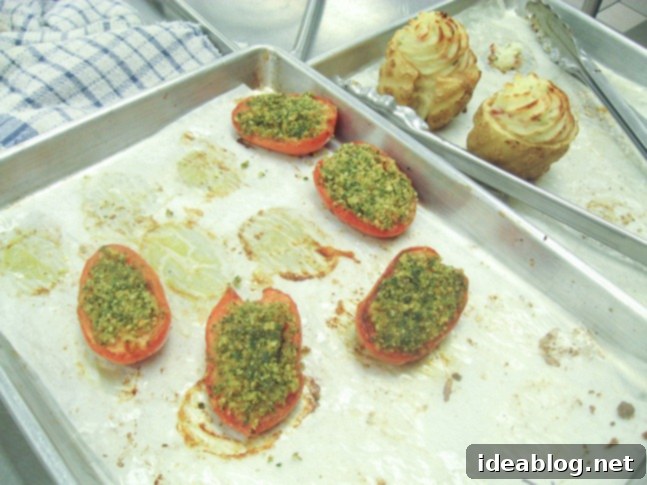Mastering Culinary Arts: A Week of Intense Training, Classic Dishes & Restaurant Challenges
This week has unfolded with an intensity that truly tested the limits of our culinary skills and endurance. What began as a typical production day in class, bustling with the creation of brand-new, intricate dishes, quickly escalated into a whirlwind of demanding experiences. The middle of the week, specifically Wednesday and Thursday, plunged us straight into back-to-back Restaurant Challenge Days. These are pivotal, recurring events in our Phase II curriculum, designed to transform our classroom into a fully operational restaurant kitchen, complete with specialized stations, and an elegant, temporary dining room. During these rigorous lunch services, we are responsible for preparing and serving exquisite meals to anywhere from 70 to 90 guests, simulating the high-pressure environment of a professional kitchen. As if that wasn’t enough, I also dedicated last night to working a catering event in the city, organized by a distinguished L’Academie graduate. The cumulative effect has certainly left me feeling accomplished, yet thoroughly exhausted, highlighting the relentless pace of a professional chef’s life.
However, amidst this flurry of activity, I’ve been eagerly anticipating the opportunity to share the highlights of Tuesday’s class with you. This particular session was exceptionally rewarding, featuring a selection of truly outstanding dishes that showcased sophisticated techniques and delightful flavor profiles, marking a significant step in our culinary journey.
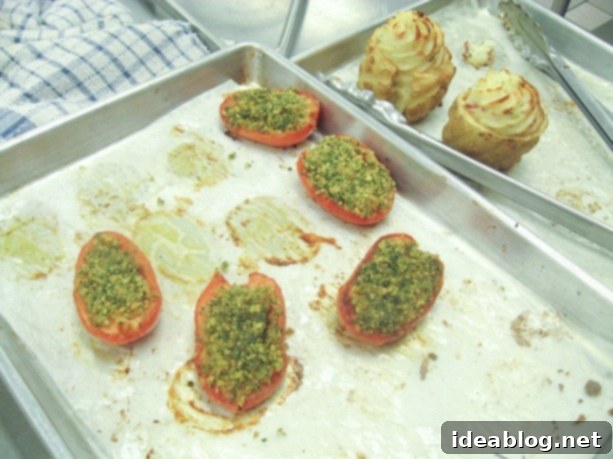
A Journey Through French Culinary Classics: Skate Fish, Steak au Poivre & More
Elegant Starter: Seared Skate Fish with Sautéed Endive and Beurre Fondu
Our inaugural course for the day presented us with skate fish, a fascinating member of the ray family, renowned for its delicate texture and mild flavor. This elegant white fish was artfully served atop a bed of perfectly sautéed endive, its subtle bitterness providing a crisp, earthy foundation. The dish was then crowned with a rich beurre fondu—essentially a luxurious emulsified lemon butter sauce—finished with a vibrant flourish of finely chopped chives, adding freshness and aromatic complexity. This class marked our first hands-on encounter with skate, requiring us to perform the disorienting, yet crucial, task of breaking down the fish ourselves. It was an eye-opening experience, not least because working with skate can be quite challenging; its unique cartilage structure requires careful handling, and we learned that direct contact can sometimes cause skin irritation due to minute, non-toxic spikes. Each piece of skate was lightly coated in seasoned flour, then dipped in egg, before being expertly seared on both sides to achieve a beautiful golden crust. The resulting flavor was absolutely superb, with the subtle bitterness of the endive providing a brilliant counterpoint to the delicate, buttery sweetness of the fish, creating a harmonious and sophisticated appetizer that truly set the tone for the meal and broadened our understanding of diverse seafood preparations.
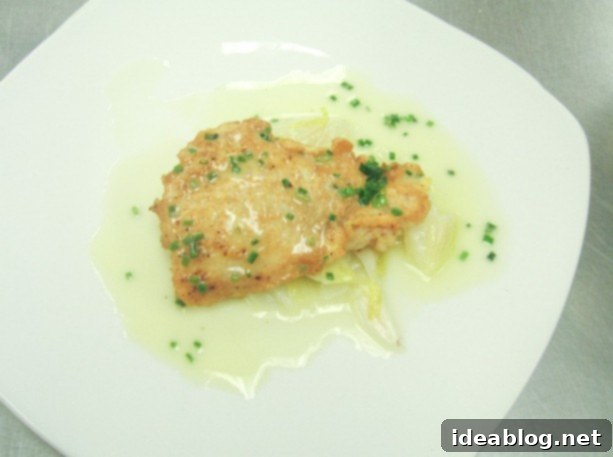
The Main Event: Classic Steak au Poivre Noir with Innovative Sides
For our main course, we prepared the quintessential French bistro dish: steak au poivre noir. We utilized high-quality top butt steak, a cut known for its robust flavor and tender texture, generously encrusting it with freshly cracked black peppercorns to ensure an intense, aromatic kick with every bite. The steak was then meticulously seared to perfection in a scorching hot pan, locking in its precious juices and developing a magnificent, dark crust, before being flambéed dramatically with fine cognac. This crucial step not only adds a profound depth of flavor through caramelization but also imparts a subtle sweetness and an incredible aroma to the dish, transforming the kitchen into a fragrant spectacle. The steak was then served with a simple yet exquisite pan sauce, crafted with care from finely minced shallots, deglazed with the residual pan juices, and enriched with a classic espagnole sauce, which provided a rich, savory complement to the peppery steak. This robust main course was thoughtfully accompanied by two equally impressive and intricate side dishes: the elegant pommes pomponette and a vibrant tomato provencale, each designed to elevate the dining experience.
Crafting Pommes Pomponette: A Culinary Masterpiece of Potato Preparation
Our potato accompaniment for the main course was nothing short of innovative and visually stunning, demonstrating a high level of culinary artistry. To create the unique pommes pomponette, we began with large, starchy russet potatoes, known for their excellent texture when cooked. Each potato was precisely cut in half, providing a stable base. The exterior of each potato half was then intricately scored in a criss-cross pattern using a specialized channel knife, a detail that not only added visual appeal but also enhanced the surface area for crisping. The interior of the potato was carefully hollowed out, creating a perfect ring shape, and the trimmings from this meticulous process were reserved for later use, ensuring no waste. These hollowed-out potato rings were then subjected to a dual cooking process: first fried in hot oil to achieve a delightfully crispy exterior, and then baked in the oven until thoroughly cooked and tender on the inside, achieving a delicate contrast of textures. The reserved potato trimmings were cooked until soft, then riced to an incredibly fine, airy consistency, similar to a purée. This light and fluffy potato mixture was then blended with fresh sour cream, adding a delightful tang and luxurious creaminess, alongside some perfectly rendered bacon and finely diced onion for a savory, umami depth, and fresh chives for a vibrant, herbaceous lift. This exquisite mixture was then skillfully piped back into the crispy potato rings, forming a delicate mound, which were returned to the oven for a final bake. This last step allowed them to brown slightly and develop an irresistible golden hue, presenting a dish that was far from your average twice-baked potato. These pommes pomponette were a testament to creative culinary artistry, offering a sophisticated texture and an explosion of harmonious flavors, truly a highlight of the meal.
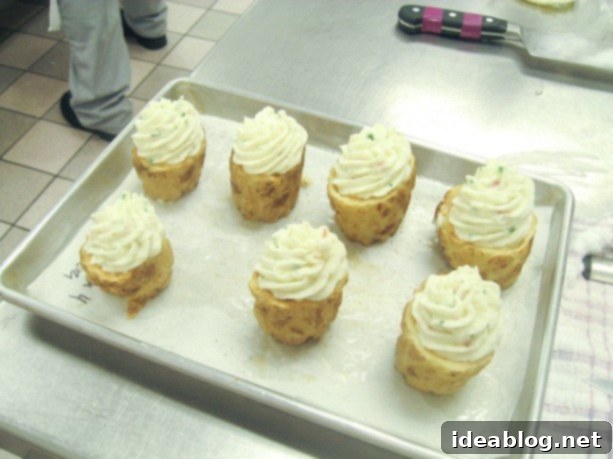
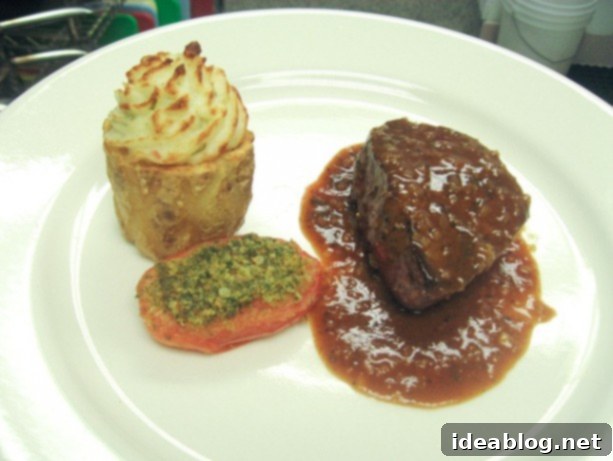
Perfecting Tomato Provencale: Simple, Yet Profound Flavors
The tomato provencale we prepared that day was, without exaggeration, the best I have ever tasted. Its exceptional flavor and texture lay in a meticulous, yet elegantly simple, preparation that showcased the beauty of fresh ingredients. We began by gently coating the halved, ripe tomatoes with a delicate, not-too-heavy mixture of breadcrumbs, ensuring a light, crispy crust rather than a dense topping. The real magic, however, came from the breadcrumb mixture itself, which was generously infused with an abundance of fresh, finely chopped parsley, pungent minced garlic, and just a hint of high-quality extra virgin olive oil. This aromatic combination, rich in herbaceous notes and a subtle pungency, created a flavorful crust that perfectly complemented the natural sweetness and acidity of the tomatoes, enhancing their inherent qualities beautifully. A particular joy for me was not having to undertake the often tedious task of peeling the tomatoes, allowing their natural texture and vibrant color to shine through, retaining more of their nutritional value and rustic appeal. This dish proved that sometimes the simplest techniques, executed with fresh, quality ingredients and a keen eye for balance, can yield the most profoundly delicious and memorable results, a true cornerstone of Provencal cuisine.
Decadent Finale: Chocolate Tart with Sauce Noisette
To conclude our magnificent meal, dessert was a truly delicious and visually stunning chocolate tart. This exquisite confection featured a perfectly baked pâte sucrée crust, a classic sweet shortcrust pastry, providing a crisp, buttery counterpoint that crumbled delicately with each bite. The chocolate filling itself was a triumph of texture and flavor; cooked meticulously at a low temperature, it achieved an incredibly smooth, almost pudding-like consistency that melted effortlessly in the mouth. Its intense, deep chocolate-y flavor was both comforting and sophisticated, making it a perfect, satisfying end to a substantial meal. On the side, we presented a delicate quenelle of freshly whipped cream, offering a light, airy contrast that brightened the richness of the tart. This was accompanied by a luscious sauce noisette, a unique and delightful creation that is essentially a crème anglaise—a rich custard sauce—elegantly elevated by the addition of premium hazelnut paste. This infusion imparted a wonderful nutty depth and a velvety texture to the sauce, harmonizing beautifully with the chocolate. The combination of the deep, intense chocolate, the fresh, light cream, and the aromatic hazelnut sauce was simply irresistible, showcasing a masterful balance of flavors and textures that left a lasting impression on every palate.

Reflections on Service and Future Culinary Horizons
Overall, the service experience for this particular class menu felt significantly smoother and more manageable compared to previous, more complex challenges. This improved flow was largely due to the menu’s inherent design, which, while sophisticated, allowed for more efficient preparation and timely execution—a crucial factor in the fast-paced, high-stakes environment of a culinary school kitchen. This sense of accomplishment provided a positive momentum as we transitioned into the grueling, yet invaluable, Restaurant Challenge Days—an entirely different league of culinary endeavor, demanding even greater precision, speed, and seamless teamwork under intense pressure. These challenges are meticulously designed to push us to our limits, preparing us for the intense realities and demands of professional restaurant service, simulating real-world scenarios that build resilience and expertise.
There is always more to come in the dynamic and ever-evolving world of culinary education, with new techniques to master and flavors to explore!
Looking ahead, tomorrow marks my fourth “market basket” challenge, an eagerly anticipated event that truly tests our creative and adaptive skills. This demanding exercise requires us to collaborate closely with the Phase II pastry students, fostering interdisciplinary teamwork. Together, we must conceptualize and execute a complete, cohesive meal comprising a sophisticated canapé, a well-balanced first course, a compelling main course, a delightful dessert, and a delicate mignardise. Our assigned mystery ingredients for this challenge, which must be incorporated thoughtfully into our dishes, are duck, goat cheese, and kumquat. The creative possibilities are endless, but so are the pressures of harmonizing these distinct and sometimes challenging flavors into a cohesive, innovative, and delicious menu that impresses our instructors. I am eagerly anticipating the challenge and truly hoping for a successful outcome, as these experiences are invaluable for further honing our skills in improvisation, sophisticated flavor pairing, and meticulous presentation.
